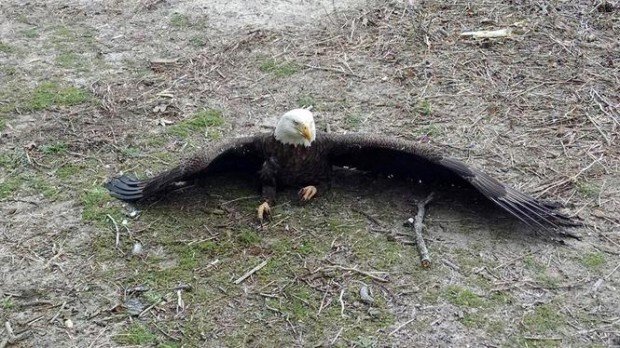
I discovered that stunning number while working on a story about the dietary habits of eagles in coastal Alabama. (They like turtles! Watch for the story next week.) Doing some research online, stories about dead eagles just kept popping up.
Someone shot one in Kentucky around New Year's Day. Two more were shot with a high-powered rifle along the shores of a lake in Idaho. Another was killed in Missouri, again with a rifle. And someone killed one early this month near Rome, Georgia.
Then comes the most distressing story. Thirteen eagles have been found dead or dying in Maryland within the last month. Authorities are still unsure what sort of poison was used to kill them, but they have ruled out natural causes. Meanwhile, five more eagles were found dead in Delaware in March.
In 17 years of covering the environment, I can recall a single story about a teen who shot an eagle with a new gun he got for Christmas back in 2008. I remember the photos of the bird, its white feathers soaked in red blood. The kid shot it just to try out his new gun. The whole episode was so depressing. But 23 eagles in less than three months! That is a lot of dead birds, and puts 2016 on pace to have more eagle killings than any year in decades.
These stories of dead eagles are particularly troubling for anyone who lived through the 1950s, 60s, or 70s, when eagles were so rare that few Americans had ever seen one. At one point, there were fewer than 500 pairs of eagles in the entire country, mostly in remote areas. I was 20 years old before I laid eyes on a bald eagle, and that was in Canada. I didn't see a bald eagle in Alabama until the year 2,000.
Like many birds, eagles were pushed to the brink of extinction by a combination of hunting, habitat loss and DDt, a pesticide that caused the thinning of egg shells, particularly of fish-eating birds, such as eagles, or pelicans. Their recovery since DDt was banned has been dramatic.
The most recent national survey suggests there are at least 10,000 breeding pairs of eagles in the nation. More than 100 of those pairs are here in Alabama. I know of five nests within 10 miles of my home, scattered around Mobile Bay, Weeks Bay and in the coastal rivers. North Alabama is home to many more eagles. I saw three eagles on Monday in the Mobile-Tensaw Delta, parents with their young eaglet, who was nearly as large as mom and dad but still couldn't fly.
For anyone who has seen a bald eagle soaring overhead, or crashing down on a fish, it is hard to understand the reasoning behind shooting one. Or poisoning more than a dozen. For those dead birds found around Chesapeake Bay, I suppose someone poisoned them because they had become a nuisance. Perhaps eating catfish out of a farm pond, or stealing chickens from one of the giant commercial chicken farms in Maryland.
Maybe the message to take from all the killings isn't that there are a lot of crummy people out there. Maybe the better message is that there are so many eagles flying around today that they can be sometimes considered a nuisance. Consider this: When I was born in 1970, there were perhaps 500 pairs in the nation. Today, there are about 1,300 pairs in Florida and Alabama alone.
That's a pretty remarkable recovery. Give some credit to the Endangered Species Act, and some to the ban on DDt. But most of the credit goes to the fact that most of us - whether we are hunters, farmers, birders, nature buffs or people who rarely walk on anything but a city street -- are simply awestruck when we see on of these giant, gorgeous birds soaring through the air.
And the last thing we can imagine doing is killing one.



This is another perfect example of how the idiots in our country respect our traditions... as in they don't, of course, most of us don't really know what they are... do we? And isn't this just like a video game? So, it's a success if the count of kills rises, no?
Yes, that is 'merican exceptionalism at work for you... bringing peace through the barrel of a gun, just the way we like it.